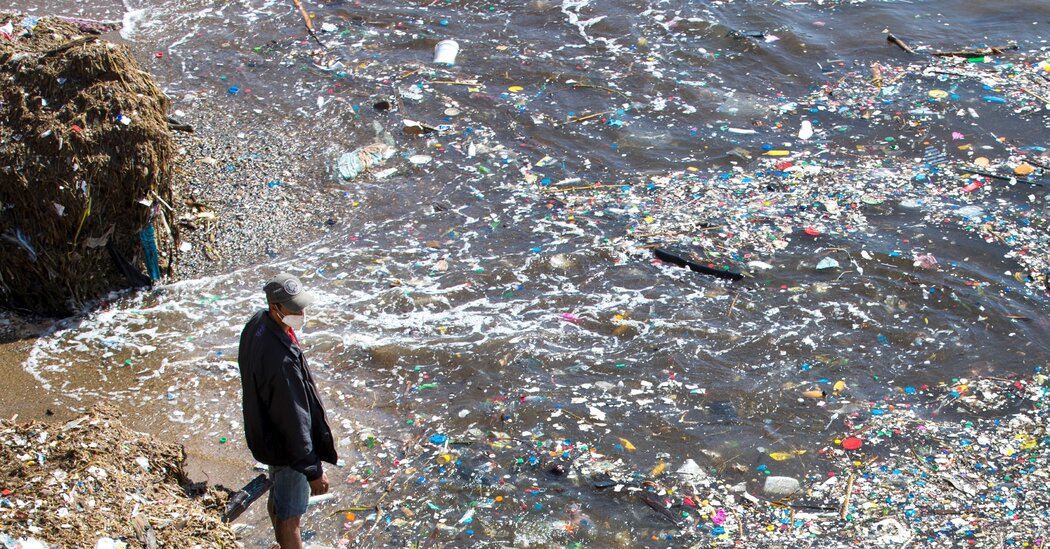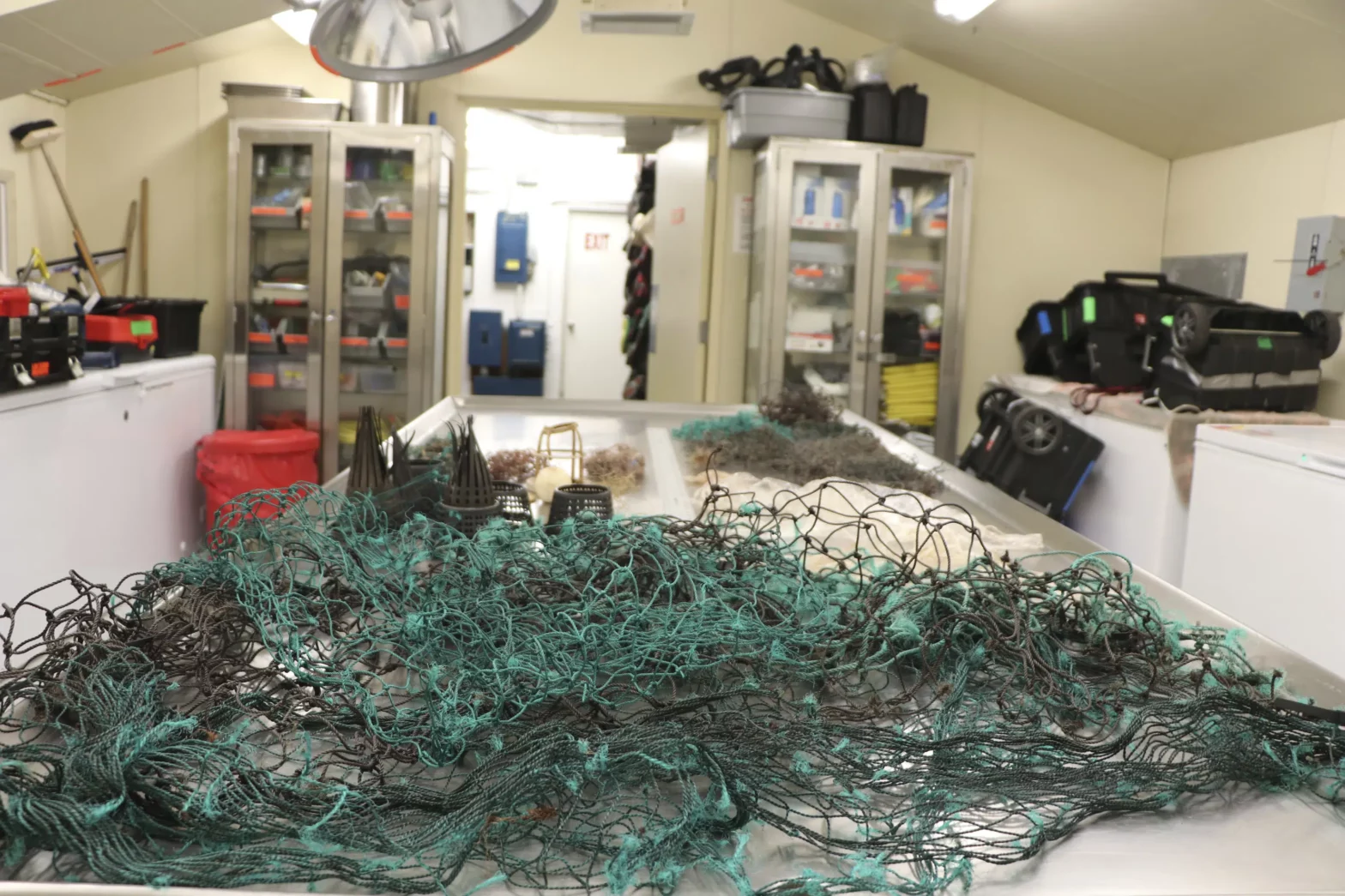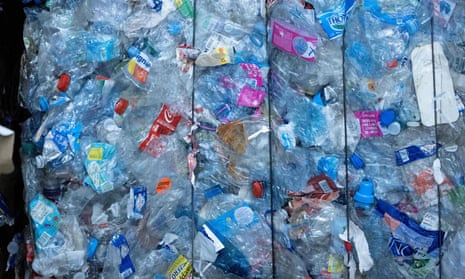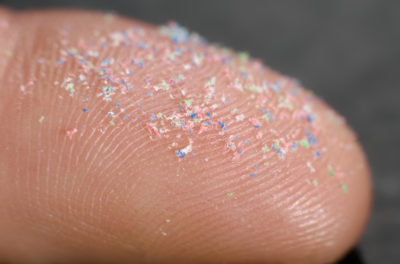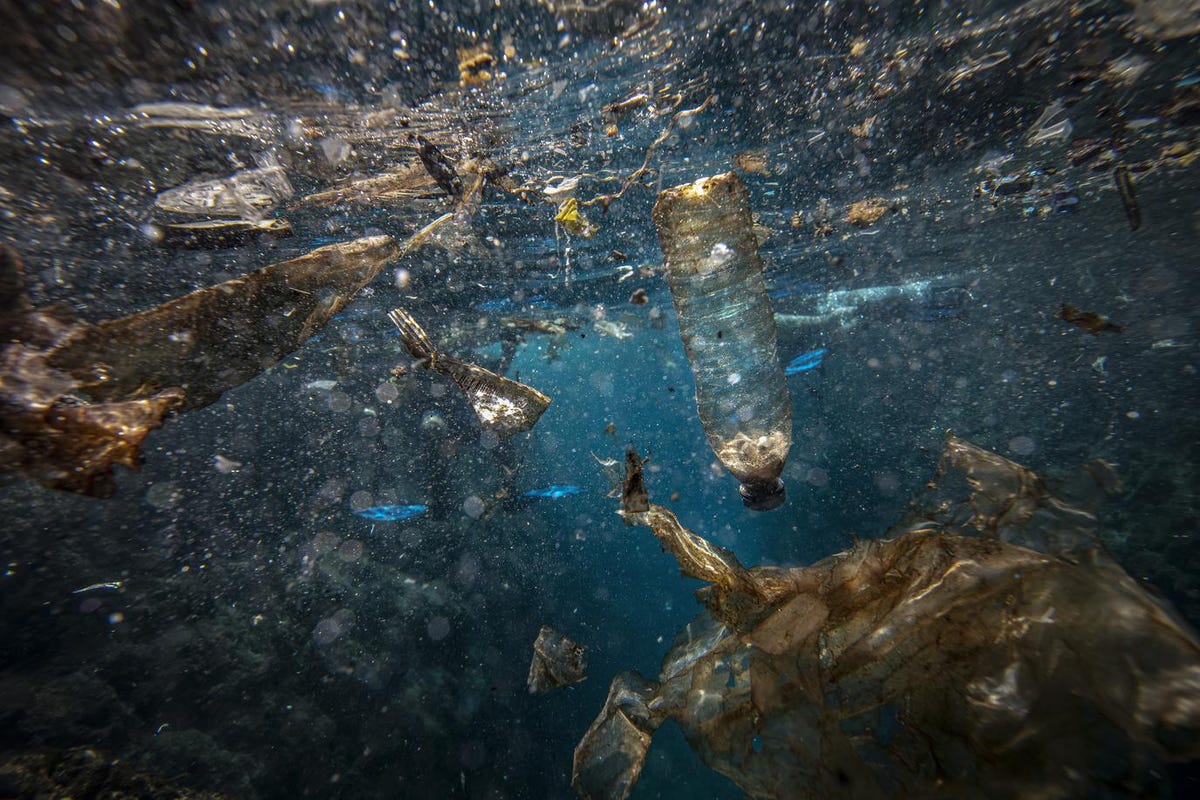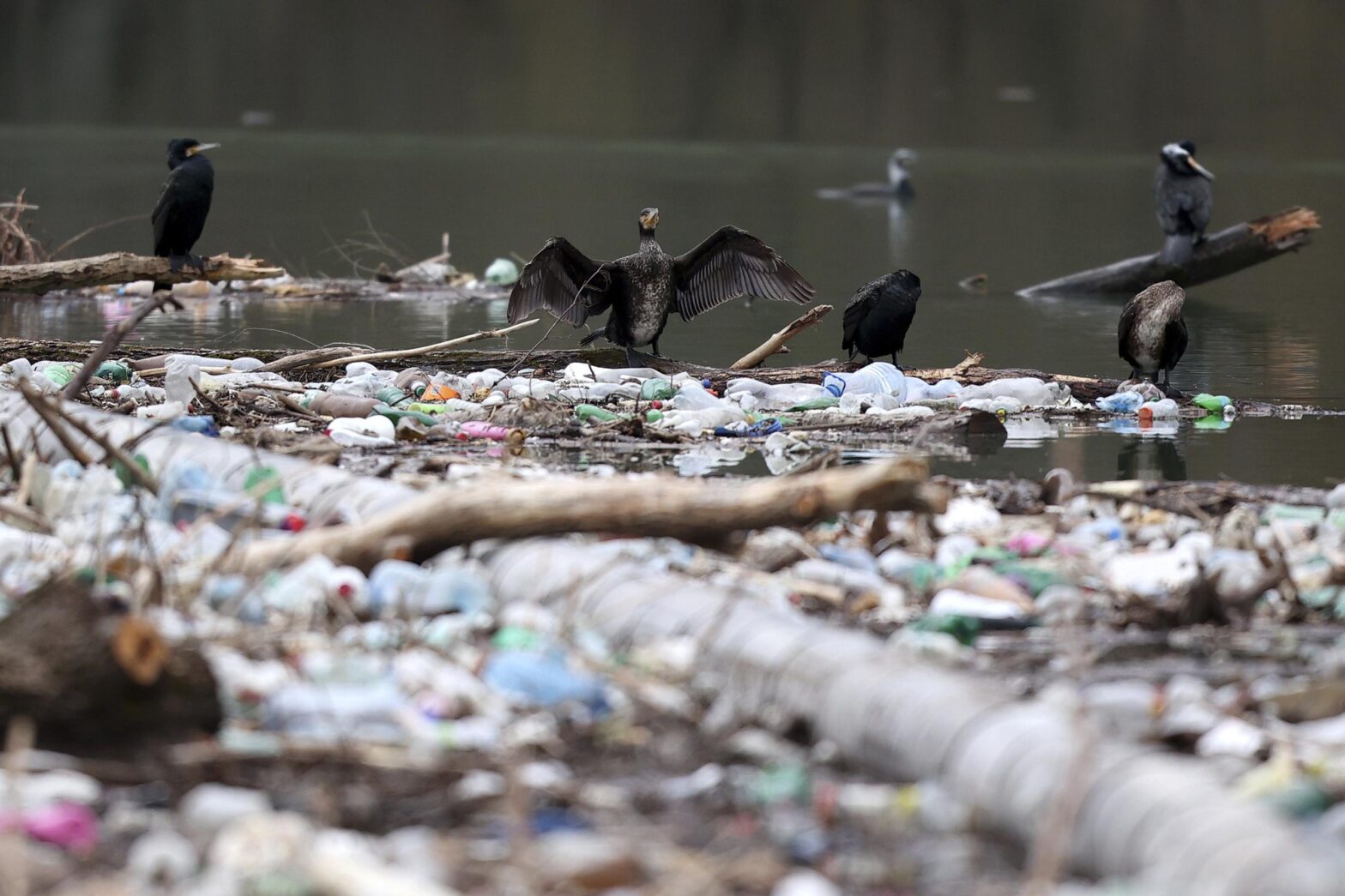Industry figures show record production in 2021, and almost none of that plastic is getting recycled.When Exxon Mobil announced a record $56 billion annual profits last week, it noted that the company had established “one of the largest advanced recycling facilities in North America, capable of processing more than 80 million pounds of plastic waste per year.”That seems like a lot of recycling muscle, except when you consider another figure. The company produced an estimated 6 million metric tons, or 13.2 billion pounds, of polymers used to make plastic in 2021 alone. That is an estimate from a report published by the Minderoo Foundation, set up by the Australian mining magnate Andrew Forrest. Minderoo tracks plastic waste and campaigns against it.Exxon is the largest producer of virgin polymers, which are derived from petrochemicals and used in plastic. The second largest is a Chinese company called Sinopec.Asked for comment on the Minderoo report, an Exxon spokeswoman said that “plastics play a vital role in everyday life” and that the company is trying to scale up recycling. “By working with others in industry, governments, communities and consumers, we are helping expand recycling programs so that more plastic waste is transformed into valuable products rather than ending up in landfills.”Despite consumer concern, we are trashing more and more plastic.Plastics production continued to grow, according to industry data. So did plastic trash: 139 million metric tons in 2021, more than ever before. That’s a lot, especially considering that plastic entered our everyday lives after World War II. They’re so pervasive that when one reporter tried to spend a day living without plastic, it yielded this delightfully absurd essay.Almost all of that 139 million metric tons of plastic is made from “virgin” petroleum products that have never been used or processed before. Barely 2 percent gets recycled, Minderoo researchers estimated.Plastic waste is more than a local environmental pollutant.It clogs streams. It chokes turtles. It gets caught on a bare branch and blows in the breeze. It stews in landfills.But it is also a climate pollutant. From the extraction of fossil fuels to make polymers to the transport and disposal of the waste, single-use plastics produced 450 million metric tons of planet-warming greenhouse gases in 2021 alone, according to estimates by Minderoo, or just below the annual emissions of Britain.Minderoo is pressing for levies on “fossil-fuel polymer production and/or consumption” to fund the collection and recycling of plastic waste.A factory in Riverside, Calif., that makes plastic containers for fruit retailers.Mark Abramson for The New York TimesWhat about those triangles and arrows on plastic products?They’re deceptive. Many of us assume the ♺ triangle means we can dispose of the product in our municipal recycling bins. Not so. Each triangle has a number within. Numbers 1 and 2 are commonly recyclable in the United States. For Numbers 3-7, it’s sometimes, rarely or never. (California banned the use of the symbol on plastics that are not widely recyclable.)Rigid plastics are more likely to be recycled than soft plastics.Some of the worst kinds of plastics are also those products that are marketed to the poor, especially in the global south, like tiny, low-priced sachets for shampoos and creams. They’re made of soft, thin plastic that’s hard to collect, sort and recycle.Here’s our guide from last year, and an earlier Climate Forward newsletter that describes how some cities outside the United States are handling plastic waste.And the plastic bag bans?There have been many such bag bans in recent years. Among the unexpected consequences: They seem to lead to an increase in plastic trash bags.We’re keeping an eye on negotiations for a global plastics treaty.This is the battleground where plastic producers, environmentalists and negotiators from every country are hammering out what is intended to be a global agreement to deal with plastic waste.The big tension is between environmental campaigners who want to curb the production of polymers, the raw goods that go into plastic, and industry groups that want to focus on how to better collect and recycle plastic.At negotiations in Uruguay in December, the United States advocated for an accord like the Paris climate agreement under which countries would set their own national voluntary targets and plans. Others, including the European Union, want mandatory global regulations for every country and company to abide by.The next round of negotiations are in May. We’ll keep you posted.Essential news from The TimesAidan Colton, an atmospheric technician with NOAA, collected an air sample atop Mauna Kea in Hawaii.Erin Schaff/The New York TimesLava, snow and science: An eruption in Hawaii briefly halted long-running climate research, but scientists found a way to carry on. They moved to a neighboring volcano.A warship’s demise: The Brazilian Navy said it had begun an operation to send the aircraft carrier São Paulo, packed with asbestos, to the bottom of the Atlantic.Bad news for bears: The Biden administration is taking a step toward lifting protections for some grizzlies. It could open the door to hunting in Montana, Wyoming and Idaho.A Canadian quarrel: The Ontario provincial government has opened up parts of the greenbelt around Toronto for the construction of 50,000 new homes. Some locals aren’t happy.How to spy on a radical group: A literary agent struck a book deal with the spokesman for the Earth Liberation Front. Literature was the least of his concerns.From outside The TimesAccording to Axios, sales of plant-based meats are collapsing and companies that make them are in trouble.Reuters reported on deadly forest fires in Chile.The United Arab Emirates chose an oil executive to lead the next global climate summit. Now The Guardian is reporting that officials are giving oil workers other roles, too.From E&E News: President Biden has appointed a climate scientist to help evaluate the effectiveness of the country’s intelligence work.National Geographic interviewed former poachers of scarlet macaws in Honduras about why they decided to protect the birds instead.A short documentary from Scientific American shows why some scientists believe plants domesticated us, not the other way around.Carbon brief explained how Britain transformed its electricity supply in just a decade.Maria ChimishkyanBefore you go: So many questions. We’ve got answers.A few months ago we invited readers to ask us their questions about climate change, and you sent in more than 1,000 responses. Wondering what we did with all those questions? We used them to build an interactive F.A.Q. feature that lets you type in queries about climate change, in your own words, and get answers written by The Times’s climate reporters and editors. Please give it a try.We goofed: The Friday newsletter misstated the name of an advocacy group. It is Rewiring America, not Rewriting America.Thanks for being a subscriber. We’ll be back on Friday.Manuela Andreoni, Claire O’Neill and Douglas Alteen contributed to Climate Forward. Read past editions of the newsletter here.If you’re enjoying what you’re reading, please consider recommending it to others. They can sign up here. Browse all of our subscriber-only newsletters here.Reach us at climateforward@nytimes.com. We read every message, and reply to many!
Author Archives: David Evans
Huge fire rips through plastics factory in south-east Melbourne
Huge fire rips through plastics factory in south-east Melbourne Crime scene established at Keysborough as residents within 2km warned to stay indoors Follow our Australia news live blog for the latest updates Get our morning and afternoon news emails, free app or daily news podcast A crime scene has been established after a fire engulfed …
Continue reading “Huge fire rips through plastics factory in south-east Melbourne”
Have climate questions? Get answers here
By some estimates, the world’s food system is responsible for one-quarter of humanity’s greenhouse gas emissions. It happens because forests get cleared to make room for farms and livestock. Cows and rice paddies emit methane, a potent greenhouse gas. Fossil fuels are burned to power farm machinery, make fertilizer and ship food.Anyone focused on the climate effects of diet should keep a few broad things in mind. First, beef, lamb and cheese tend to have the biggest effects on emissions by far — creating the most greenhouse gases per gram of protein — in part because cows and other ruminants are more resource-intensive to raise. Pork, chicken, eggs and many types of fish typically have smaller effects on emissions (though they can create other environmental concerns). Plant-based foods usually produce the fewest emissions of all.So the most straightforward way of reducing diet-related emissions is to consume less meat and dairy and more plants. It’s especially the case if you live in the United States, where red meat consumption is much higher than in many parts of the world.According to a World Resources Institute analysis, if the average American simply replaced a third of the beef they eat with lower-emissions pork or poultry or legumes, their food-related emissions would fall 13 percent. Moreover, a number of studies have found that people who currently eat a meat-heavy diet could shrink their food-related footprint by one-third or more by going vegetarian.It sounds like a no-brainer, but the other big way to shrink the climate effect of your diet is simply to waste less food. According to some estimates, Americans throw out roughly 20 percent of the food they buy.Other popular strategies are less clear-cut, at least when it comes to greenhouse gas emissions. Studies differ on whether grass-fed beef, for instance, is any more climate friendly than conventional feedlot beef, although some argue it’s better for animal welfare. Organic crops tend to require more land than traditional crops, which could lead to more emissions if such farming results in more deforestation. As for debates over locally grown produce, or paper vs. plastic bags, those are relatively small in the grand scheme of things, since transportation and packaging are a sliver of food’s climate effects.And, of course, there are other concerns besides climate change.For example, when compared with meat, wild fish can be a lower-emissions option. But that comes with a caveat: The world is already catching about as much wild fish as it possibly can. Most fisheries are being fished at their maximum sustainable level, while others are being overexploited. So more people switching to fish could require, among other actions, increasing the number of sustainable fish farms worldwide.
— Brad Plumer
Read more:
Your Questions About Food and Climate Change, Answered
Hawaii whale dies with fishing nets, plastic bags in stomach
HONOLULU (AP) — A whale that washed ashore in Hawaii over the weekend likely died in part because it ate large volumes of fishing traps, fishing nets, plastic bags and other marine debris, scientists said Thursday, highlighting the threat to wildlife from the millions of tons of plastic
Coles and Woolworths ordered to dump more than 5,200 tonnes of recycled soft plastic in landfill
Coles and Woolworths ordered to dump more than 5,200 tonnes of recycled soft plastic in landfill NSW environment officials alert Fire and Rescue over concerns plastic is being stored dangerously following suspension of the REDcycle scheme Follow our Australia news live blog for the latest updates Get our morning and afternoon news emails, free app …
Swallowed fishing gear and plastic most likely cause of Hawaii whale’s death
Swallowed fishing gear and plastic most likely cause of Hawaii whale’s death Large volumes of traps, nets and marine debris in sperm whale’s intestinal tract highlight plastic pollution’s threat to wildlife A sperm whale that washed ashore in Hawaii over the weekend probably died in part because it ate large volumes of fishing traps, fishing …
Continue reading “Swallowed fishing gear and plastic most likely cause of Hawaii whale’s death”
Microplastics are filling the skies. Will they affect the climate?
Recent studies reveal that tiny pieces of plastic are constantly lofted into the atmosphere. These particles can travel thousands of miles and affect the formation of clouds, which means they have the potential to impact temperature, rainfall, and even climate change.
Nets, plastic, underwater crime
We’ve all seen them. Images of countless turtles, whales, dolphins, sharks, and seals, dead and entangled in abandoned fish nets. The ocean is becoming an increasingly dangerous place for its inhabitants. And not because of the ‘eat or be eaten’ laws of nature – but because just by nature of being a creature that swims, you’re likely to eat plastic that may kill or maim you, or end up trapped and entangled in a net, left to struggle in an unnatural death until you starve, suffocate, or become prey.
It’s one thing to talk about statistics and science, but the violence, pain and suffering our throwaway plastic culture has caused is something that can’t be measured in numbers.
The ocean has become a crime scene. Currently, there are an estimated 50-75 trillion pieces of plastic and microplastics in the ocean. The plastic either ends up forming giant garbage patches, or breaking down into microplastics.
Plastic waste makes up 80% of all marine pollution and an estimated 8-10 million metric tons of plastic waste end up in the ocean every year. If current trends continue, by 2050, plastic is expected to outweigh all fish in the sea.
Imagine going for a seaside holiday and swimming in an ocean of plastic? Imagine a sea devoid of life – the magnificent underwater world destroyed because we treated the ocean like a giant garbage dump?
In just the last decade, humanity produced more plastic than it did in the last century. In most supermarkets, fruit and vegetables are wrapped in single-use plastic packaging, but every piece of single-use plastic takes between 500 -1,000 years to degrade. And when it degrades, it does not decompose, it becomes microplastics which are poisonous to animals and humans.
The Environmental Protection Agency has stated that 100% of all plastics human beings have created still exist.
One of the most harmful types of marine plastic debris is abandoned, lost, discarded fishing gear. About 640 thousand tons of fishing equipment get dumped into the ocean each year, not only entrapping marine life, according to researchers from the WUN Global Research Group, “there is chemical contamination with disruptive effects on marine species. As a result, human health is also impacted, with marine litter serving as a vehicle for diseases that contaminate the food chain.
“The problem is more visible in Asian countries like Taiwan, which has one of the world’s largest fishing fleets. In Taiwan, an average of 12.7 m3 of marine litter accumulates per kilometer along the coastline, 70% of which is caused by fishing gear.”
Each year, an estimated 100,000 sea animals are killed by plastic, around 90% of seabirds have eaten plastic, and one in every three sea turtles.
In a study that examined how to stop fishing gears from turning into ocean waste, scientists recommend not only better monitoring and managing of data on fishing gear waste streams by governments, but also regular meetings between stakeholders including the fishery sector, government agencies and non-governmental organisations to share knowledge and work towards implementing solutions for more sustainable fisheries.
Ocean plastic removal initiatives range from The Ocean Clean up, which aims to remove 90% of the plastic in the ocean both by scaling solutions to remove debris from the ocean and to intercept plastic in rivers before it reaches the ocean.
1% of the world’s rivers – 1,000 rivers – are responsible for 80% of the plastic that flows into the oceans, so stopping plastic trash has to start with cleaning up rivers.
Ocean plastic removal initiatives like non-profit organisation The Ocean Clean up have developed a range of interceptor solutions to tackle the plastic trash in rivers, from building a simple ‘trash fence’ across a river to high-tech, solar powered filtration systems. The Ocean Clean up has removed an impressive 2 million kilos of trash so far.
A sailor and surfer led Dutch startup created a low-cost, low-tech solution for stopping plastic trash from entering the oceans. The Great Bubble Barrier’s (GBB) beauty is in its simplicity: a perforated tube is embedded on riverbeds, creating a curtain of bubbles which gently nudges waste to the riverbank where it can be collected.
Ichthion was first developed at London’s Imperial College. The company has developed three types of technologies to remove plastics from rivers and oceans: a barrier for plastic capture in rivers, a plastic extraction system for marine environments, and a technology which can be retrofitted to large ships for plastic removal.
River Cleaning designed a diagonal line of floating rotating cog-type devices that pass the waste along the chain until it reaches a storage area by the river bank. This ingenious technique uses the flow of water in the river to spin the cogs – so no power is required.
And while upscaling ocean clean up solutions is urgently needed in coming years, the challenge remains to tackle the problem at its root cause.
Searious Business helps companies adapt their plastic packaging towards more sustainable supply chains and business models, while innovative startups like Apeel and Geno are bringing plant-based alternatives to plastic to disrupt plastic packaging and the plastic-based fast fashion industries.
The movement to include rescuing the ocean as part of our global efforts to tackle climate action is growing. Leaders from Australia, Canada, Chile, Fiji, Ghana, Indonesia, Jamaica, Japan, Kenya, Mexico, Namibia, Norway, Palau and Portugal have joined forces to form the High-Level Panel for a Sustainable Ocean Economy to accelerate ocean protection in policy, governance and finance. The ocean as we know it is a ticking time bomb – an accumulating trap of debris and toxins that are being carried into and poisoning the food chain. But hope stems from the growing awareness and accountability for how human survival depends on our ability to care for and protect the natural world.
Serbia, Montenegro, Bosnia do little to solve waste problem
PRIBOJ, Serbia (AP) — In southwest Serbia, construction machines are being repurposed to clear tons of waste clogging the Potpec lake. Year after year during the winter months, the lake near the southwest Serbian town of Priboj fills with tons of garbage such as plastic bottles, rusty barrels, dead animals and even furniture or home appliances. That’s because the Lim river feeding into the lake swells during the winter months and sweeps up trash from dozens of illegal landfills along its banks, as it flows from Montenegro to Serbia. It’s much the same in neighboring Bosnia’s Drina river into which the Lim eventually flows. The problem spans decades and stems from poor waste management and a general lack of environmental protection safeguards across the Balkans. Workers clearing the garbage with small cranes at the Potpec lake this week said the machines often break down because there is simply too much trash. Moreover, the cranes just weren’t designed to pick up large chunks of wood or heavy washing machines from the water. ADVERTISEMENT “You would not believe the things people throw into the river,” said Milan Visic, a tugboat pilot. “It is in fact much better now than it was before because we cleaned up a lot.”The workers say they have collected some 10,000 cubic meters (more than 353,000 cubic feet) of waste since early December. But their job is far from over as much more garbage remains piled up in the lake. . Officials from Serbia, Bosnia and Montenegro have on several occasions pledged to work together to solve the problem affecting their shared rivers but little has been done in reality. All three countries are aspiring to join the European Union and are expected to do more for to protect their environment if their accession bids are to move forward. Another pressing issue is the extremely high level of air pollution affecting a number of cities in the region.The garbage problem is evident everywhere – piles of waste dot hills and valleys, trash lines roads and plastic bags twist from tree branches. Compounding the problem is that collected trash is simply dumped in a landfill and recyclables are hardly ever seperated.Environmental activists say tough action is needed now. “For a start, heavy fines should be slapped,” for throwing waste around, said Sinisa Lakovic of the local Jastreb group.
Michigan announces first settlement of 2020 PFAS litigation
Michigan has reached its first settlement in a series of lawsuits over PFAS contamination.PFAS are a group of chemicals known for the long time they take to break down. Some kinds have been linked to certain cancers.Under the agreement announced Monday, the plastics company Asahi Kasei Plastics North America (APNA) will have to pay for the full cost of cleanup in Livingston County. Those could total in the millions.It will also have to pay for the state’s legal fees.During a media briefing, Michigan Attorney General Dana Nessel said she hopes this settlement will lead other companies to follow suit.“It’s a really simple policy. You made the mess, you clean it up. The end. That’s what we’re looking for,” Nessel said.Two of the state’s PFAS litigation cases remain pending in state court while others, including lawsuits against 3M and DuPont have been wrapped up in multi-district litigation.Nessel told reporters Asahi Kasei’s case became separate because the company wanted to settle.When asked for a comment, an APNA spokesperson pointed to the company’s partnership with the Michigan Department of Environment, Great Lakes, and Energy outlined in the consent degree.“Our President and Chief Operating Officer, Todd Glogovsky, would like to stress that APNA is a proud Michigan employer with deep ties to the local community. We are committed to protecting and preserving our State’s environment and acting as a responsible corporation and member of the community,” the spokesperson said in an email.The extent of possible contamination within Livingston County is unknown. It will be Asahi Kasei’s responsibility under the settlement to pay for the costs of investigation.Michigan Assistant Attorney General Polly Synk said she’s not sure how long it will take the state resolve the issue. She estimated it probably will take longer than “a couple months,” but she doesn’t anticipate it stretching endless years.”“This is an area where EGLE knows the groundwater, they know the depth of groundwater, they know the flow, so there’s a lot known. But once you find it, these are forever chemicals so sometimes treatment can take a long time, even when once you have a handle on the situation,” Synk said.Some environmental groups are celebrating the agreement as a milestone in the fight against PFAS contamination.Tony Spaniola co-chairs the Great Lakes PFAS Action Network. He said he’s most encouraged by the state’s commitment to bring PFAS cases to trial if need be.“It’s like saying, ‘You know what? We have a police force that’s actually going to enforce the law.’ And so, we ought to all be feeling a little safer because of that. That doesn’t mean that we’re all set and we’re out of the woods because there’s a whole bunch of other lawsuits going on,” Spaniola said.He said another main piece of the settlement he believes should get more attention is that affected community members get to weigh in on Asahi Kasei’s remediation action plan.Spaniola stressed Michigan needs to address statute-of-limitations laws that prevent some affected communities from pursuing polluters in court. He also said the state should strengthen its polluter-pay laws as well.

